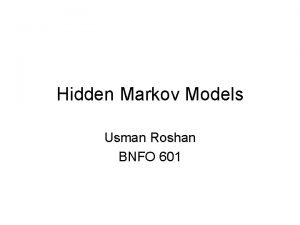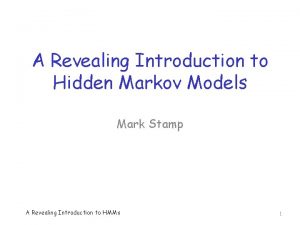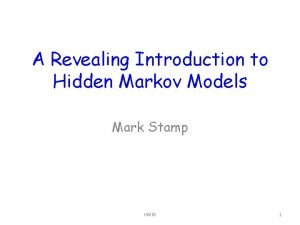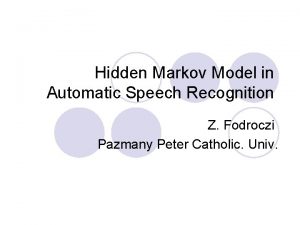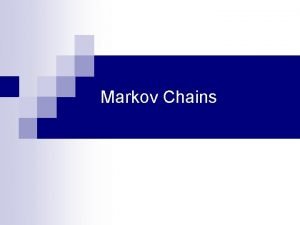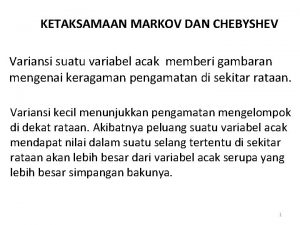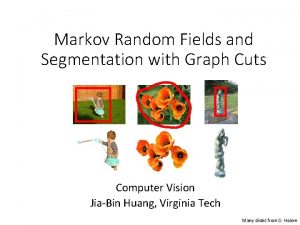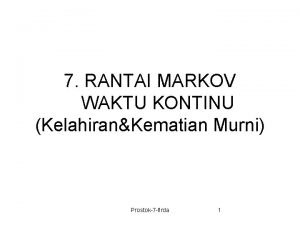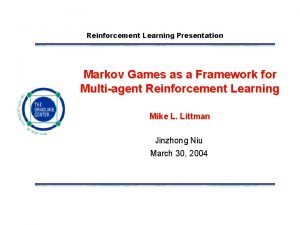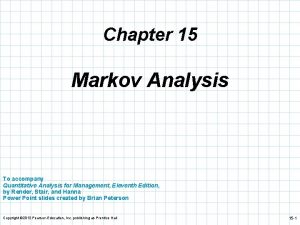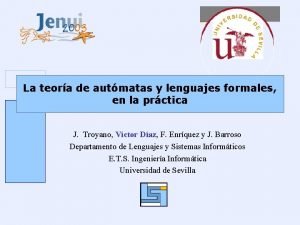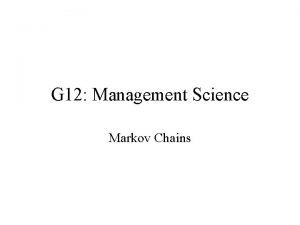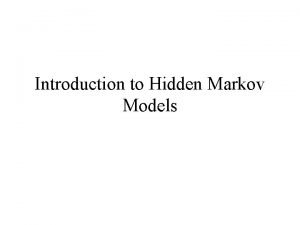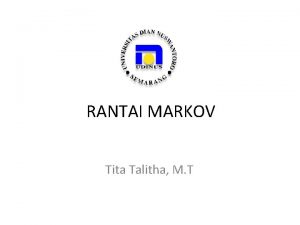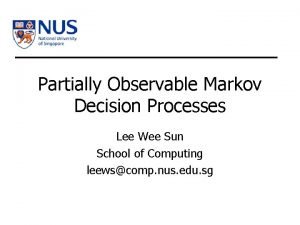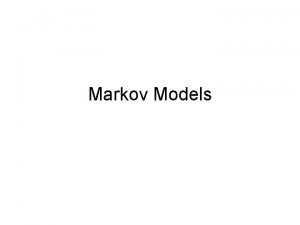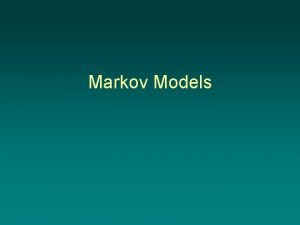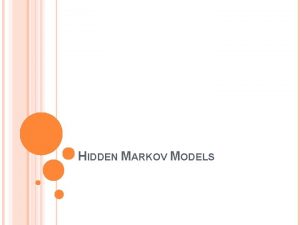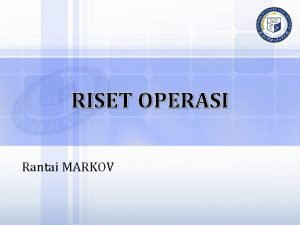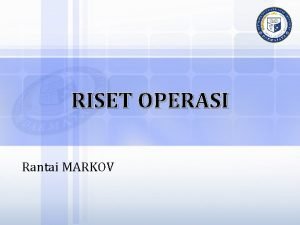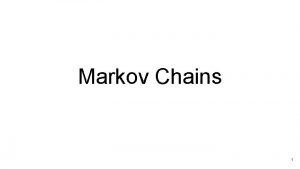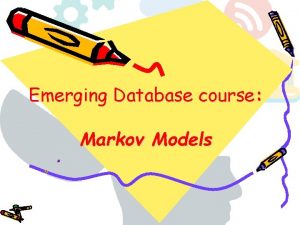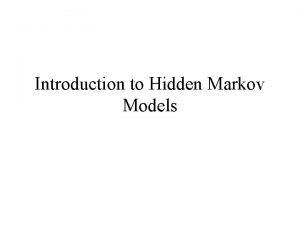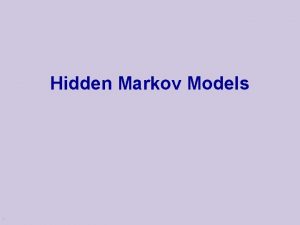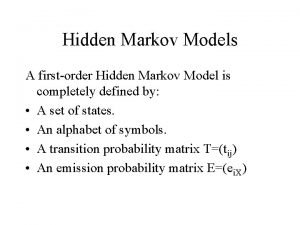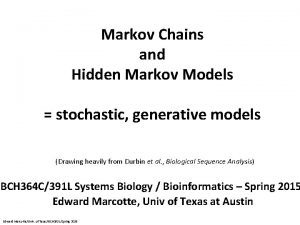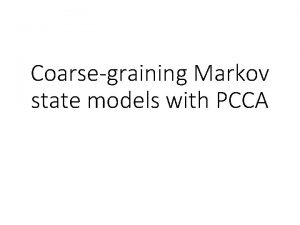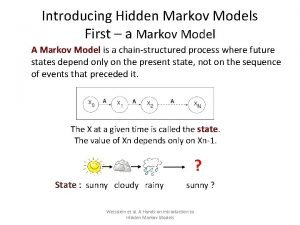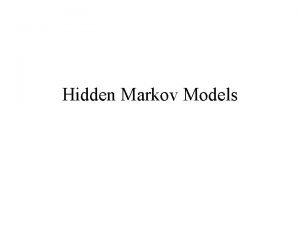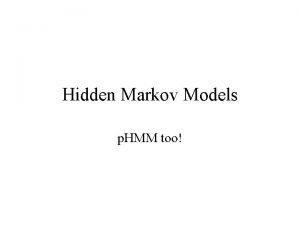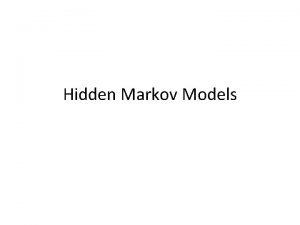Markov Models Agenda Homework Markov models Overview Some
































- Slides: 32

Markov Models

Agenda • Homework • Markov models – Overview – Some analytic predictions – Probability matching • Stochastic vs. Deterministic Models • Gray, 2002

Choice Example • A person is given a choice between ice cream and chocolate. • The person can be – Undecided. – Choose ice cream. – Choose chocolate. • There is some probability of going from being undecided to – Staying undecided and giving no decision. – Choosing ice cream. – Choosing chocolate.

Markov Processes • States – The discrete states of a process at any time. • Transition probabilities – The probability of moving from one state to another. • The Markov property – How a process gets to a state in unimportant. All information about the past is embodied in the current state.

State Space SIce Cream SUndecided SChocolate

Transition Probabilities P(SU|SU)=1 -( + ) P(SI_C|SU)= SIce Cream P(SI_C|SI_C)=1 SUndecided P(SC|SU)= SChocolate P(SC|SC)=1 Note: The transition probabilities out of a node sum to 1. How can this model be made equivalent to Luce Choice?

Transition Probabilities P(SU|SU)=1 -( + ) P(SI_C|SU)= SIce Cream P(SI_C|SI_C)=1 SUndecided P(SC|SU)= SChocolate P(SI_C|SU) = v(I_C)/(v(I_C)+v(C)) P(SC|SU) = v(C)/v(I_C)+v(C)) P(SC|SC)=1

Transparent Responses P(SU|SU)=1 -( + ) P(SI_C|SU)= SUndecided SIce Cream P(RI_C|SI_C)=1 P(SC|SU)= SChocolate P(Rnone|SU)=1 P(SI_C|SI_C)=1 P(RI_C|SC)=0 P(SC|SC)=1

Transparent Responses P(SU|SU)=1 -( + ) P(SI_C|SU)= SUndecided SIce Cream P(RI_C|SI_C)=. 8 P(SC|SU)= SChocolate P(Rnone|SU)=1 P(SI_C|SI_C)=1 P(RI_C|SC)=. 2 P(SC|SC)=1

State Sequence Hidden SU SU SU SC SC … Observed Time None Choc. … t 1 t 2 t 3 t 4 t 5 …

Matrix Form of Transition Probabilities To From SU SI_C SC SU 1 -( + ) SI_C 0 1 0 SC 0 0 1

Some Analytic Solutions Where =P(SI_C|SU) and =P(SC|SU)

Some Analytic Solutions What happens if: • + =1? • t=1?


More Analytic Solutions


Problem? • Why don’t the choices sum to 1?

More Results… • The matrix form is very convenient for calculations. • It is easy to calculate all moments. • More to come with random walks…

Pair Clustering • Batchelder & Riefer, 1980 – Free recall of clusterable pairs. – Implements a Markov model for the probability that a pair is clustered on a particular trial. • Are MPTs Markov models?

Probability Matching • Paradigm – Warning light – Prediction: P(R 1), P(R 2) – Feedback: P(E 1)= , P(E 2)=1 - • Typical result – P(R 1)

Probability Matching • Can be implemented via a Markov model. • Assume win-stay/lose-shift paradigm – If “correct”, make same prediction – If “incorrect”, shift response with probability . • Associate an “element” with most recent event, but not perfectly.

Current Trial Next Trial R 1 E 1 R 2 E 1 R 1 E 2 R 2 E 2 R 1 E 1 0 1 - 0 R 2 E 1 (1 - ) R 1 E 2 (1 - ) R 2 E 2 0 0 1 - Ri. Ej = Response i and then Feedback j. = Probability of Feedback 1. = Probability of switching after error.


Markov Property

Light 2 Light 1

Markov Property P(Honk) = 0. 7 L 1/Go L 2/Go . 3. 3 L 1/Stop P(Honk) =. 3 . 7 L 2/Stop P(Honk) =. 4

Markov Property L 1/Go L 2/Go P(Honk) =. 3 P(Honk) =. 4 L 1/Stop L 2/Stop P(Honk) =. 8 P(Honk) =. 7 L 1/Stop Repeat L 2/Stop Repeat

Stochastic vs. Deterministic • Stochastic model: The processes are probabilistic. • Deterministic: The processes are completely determined.

Stochastic Models Imply: • Psychological events are uncertain – Even if we had all the knowledge we needed we could still not figure out what a person is going to do next. • Or

Stochastic Models Imply: • The model does not capture all aspects of the behavior in question – Allows the model to focus on certain parts of behavior and ignore others. – You may believe behavior is deterministic, but still rely on a stochastic model. – Allows the modeler to finesse some ignorance. • OR

Stochastic Models Imply: • Some parts of the task are truly random – E. g. , feedback schedule from the experimenter in a probability matching task.

Limitation of Stochastic Models • You need to test them on populations of behavior, not individual behaviors. – E. g. , I gave Participant X a single choice and she chose ice cream. – Can we test the model against this datum?
 Hidden markov models
Hidden markov models A revealing introduction to hidden markov models
A revealing introduction to hidden markov models A revealing introduction to hidden markov models
A revealing introduction to hidden markov models Agenda sistemica y agenda institucional
Agenda sistemica y agenda institucional Homework oh homework i hate you you stink
Homework oh homework i hate you you stink The zebras cried when the wise old elephant died
The zebras cried when the wise old elephant died Parts of a poem
Parts of a poem Homework i love you poem
Homework i love you poem Jack prelutsky homework oh homework
Jack prelutsky homework oh homework Homework oh homework i hate you you stink
Homework oh homework i hate you you stink Cake is a countable or uncountable noun
Cake is a countable or uncountable noun What is contact force
What is contact force They say it only takes a little faith to move a mountain
They say it only takes a little faith to move a mountain Some say the world will end in fire some say in ice
Some say the world will end in fire some say in ice Fire and ice diamante poem
Fire and ice diamante poem They say it only takes a little faith to move a mountain
They say it only takes a little faith to move a mountain Some trust in horses
Some trust in horses Semi modals examples
Semi modals examples Markov modell
Markov modell Markov model
Markov model Dt sdy
Dt sdy Hidden markov model
Hidden markov model Chapman kolmogorov equation
Chapman kolmogorov equation Contoh soal ketaksamaan chebyshev
Contoh soal ketaksamaan chebyshev Markov random field
Markov random field Rantai markov waktu kontinu
Rantai markov waktu kontinu Hidden markov model rock paper scissors
Hidden markov model rock paper scissors What is markov analysis
What is markov analysis Cadenas de markov caracteristicas
Cadenas de markov caracteristicas Aperiodic markov chain
Aperiodic markov chain Hidden markov chain
Hidden markov chain Pijipin
Pijipin Markov decision process
Markov decision process
